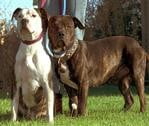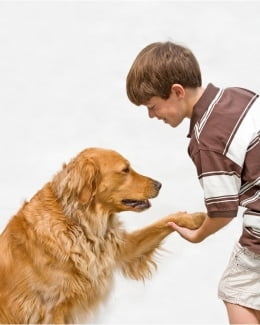Aggression of dogs towards children is a concern for all
Is a dog man’s best friend or worst fiend?
Is a dog man’s best friend or worst fiend?
Most of us love dogs, but regretfully dog attacks do occur and when the attacks are directed towards children, it is particularly tragic. For parents, when their pet dog is aggressive towards their children, the emotions and conflict the parents experience are extreme, especially as most parents regard their dog with the same emotional attachment that they have for their children. It’s is worse still if the dog was the parent’s child substitute before the child was born.
Thankfully, there are ways of reducing the risk of aggression towards children.
What are the risks of dog bites for families?


Certainly dogs injure and even kill people.
The Flinders University Research Centre for Injury Studies has reported on dog bite injuries over an eight period year from1986 – 1994 where over 700,000 injuries treated at a variety of hospital emergency departments were analysed. Dog bites represented 7591 (1%) of the injuries presented.
In Australia from 1976 – 1996, there were eleven fatalities caused by dog bites, of which 36% were in young children under four years and 36% were in elderly folk over 75 years.
To put this into perspective, these fatalities should be compared with those caused by other animals. For instance, in much the same period, there were 52 snake bite fatalities and 10 crocodile fatalities in Australia.
As we don’t live every day with snakes and crocodiles in our lounge rooms, this shows that dogs are surprisingly friendly animals. Why is this so? Mainly because through deliberate domestication of dog, we humans have orchestrated an alteration of their gene pool to create animals that, mostly, have stable temperaments. Nevertheless, dog bites do occur and they can be dangerous and even fatal.
When it comes to kids and pets, research at the Royal Children’s Hospital in Brisbane and the Flinders University in Adelaide confirms that children under 10 years represent 43 % of emergency treatments at hospital where dog attacks are involved.
The head, neck and trunk represent 48% of these injuries and where the face is bitten, the lips and nose are more often affected. The life-long disfigurement caused by dog attacks is a sad consequence of pet ownership gone wrong.
Children are extremely vulnerable to dog attacks because:
- they are often of similar size, height and weight as the dog
- children do not know how to handle themselves around dogs
- children spend more time in the dog’s environment (in the garden, playing on the floor and so on) than the parents
- children are active, noisy and unpredictable in their actions
- considering the immense ability of dogs to detect smells, children often proffer the challenge of different odours and scents to adults.
The sad statistics also confirm that:
- three quarters of dog attacks occur in boys
- sixty percent of injuries occur in the home or garden
- more bites occur on the weekends
- one in seventeen cases requires admission to a hospital.
What Breeds Bite Most?
Defining the breeds that cause attacks is always a treacherous sea. Where statistics are available, the breed description is either that given by the victim or that given by the dog owner. Breed descriptions relating to dog attacks should be regarded as general description of appearance only.
Nevertheless, statistics from the Brisbane City Council are useful. Here, the dog’s breed is defined by the owner of the dog and show that German Shepherd type dogs usually cause more bites than any other breed. Followed by, and sometimes superseded by, the Australian Cattle Dog, and very close on its heels are dogs described as Bull Terrier types.
However, German Shepherds are the most commonly owned breed of dog in Brisbane at almost 11% of the dog population. When the ownership levels are taken into account, dogs of the Bull Terrier type usually rank as the most dangerous dog on a per capita basis. Bull Terriers are represented by almost 3% of the Brisbane dog population. The breed that ranks in second place for attacks is the Australian Cattle Dog (the second most common dog owned at 10% of the population) and third place is taken by the German Shepherd.

From my business as a veterinary behaviourist, I see Staffordshire Bull Terrier and Bull Terrier type dogs as the types presented most commonly with aggression. They represent 23 % of my aggressive-dog case load. Following are German Shepherd types at 17%, Cattle Dogs at 16%, Border Collies at 14%, Rottweilers at 13% and, in the small dog category, Maltese Terriers are the most common at 6.4% of all cases. Note that aggression in these cases does not refer only to children.
What are the Benefits of Pet Ownership for Children?

So, we have examined the danger that an aggressive pet dog poses to the children in the family. Now, let’s look at the flip side and show that children reap great benefits from pet ownership. When it comes to determining the benefit children get from pets, American child psychologist Boris Levinson lead the way. He was one of the first to notice how pets improve a child’s behaviour.
Levinson worked with a boy who had many problems associated with social contact. On one occasion Levinson happened to have his dog in his office when the boy arrived earlier than expected for an appointment. The boy began to interact with the dog and to Levinson’s surprise spoke to the dog. This was remarkable because Levinson had not been able to provoke speech during the previous month. This was the beginning of his research which has inspired many others to investigate why pets are important to children.
Children with Psychological Challenges
We now know that pets provide clear benefits for children (and adults) afflicted with a range of psychological disorders.
The benefits are particularly significant with autistic children. It is fascinating that Autistic children show behaviours towards their pets that they rarely, if ever, show towards their human companions. In particular, autistic children seek out pets for companionship and comfort and confide in pets in ways that these children never show to family members.
Autistic children show greater sensitivity towards the needs and feelings of the animal than they show to people, together with a lack of anger and aggression. Autistic children often dislike being touched or hugged by people, but studies have shown that autistic children showed clear enjoyment in the tactile comfort given by pets. These results suggest that children with autism may be able to demonstrate behaviours towards pets that they do not display to people, even family members, and that these behaviours are akin to those associated with close relationships.
Children and Family Pets
Researchers tell us that owning pets makes children more empathic, a trait seen even in pet-owning children of three to six years of age.

Pets also provide emotional support for children. When asked, children often nominate that they would turn to pets in place of people when faced with a problem or when needing comfort. Whereas parents and siblings sometimes judge and criticize, pets don’t and pets can therefore make children feel unconditionally accepted. Further, social support given by other humans can be threatening but this is not so with pets.
A wonderful benefit of pets is their enduring affection. This is a significant source of the benefit and pleasure that pets can bring to children because kids sense that pets will love and accept them unconditionally. If a child gets angry or performs poorly at school, if this child has problems with his or her relationships with other friends or experiences bullying, the pet will provide a source of non-judgemental affection that is a wonderful solace.
Of course, dogs are teachers of biology as children learn about the pet’s health care needs and share the pet’s maintenance.
Reducing the risk of pets to kids
Clearly, pets are good for kids, so the last task is to reduce the risks of pet ownership and that’s not difficult. You need to start at the beginning and select a pet that is suitable for your lifestyle. Dogs are not suitable for all, and families with busy lifestyles may be better choosing a cat, some fish or perhaps a bird.
If you choose a dog, you need to carefully consider the breed and next, to choose a pup with a stable temperament. In the home, you need to carefully handle interactions between your dog and your children. By their very nature, children and dogs are an excitable combination so it’s the parent’s role to oversee the interactions.
Be cautious with visiting children and unless you know that your dog is bomb proof, confine it away from the children. For your own kids, teach them how to approach dogs and how to behave around them. Lastly, coach your children on what to do if they are confronted by an aggressive dog.
So, while dogs can be dangerous to children, simple precautions make dog ownership the joy is should be – for kids, parents and the pooch!
